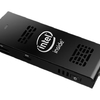This article is more than 1 year old
Intel's Compute Sticks stick it to Windows To Go, Chromecast
Tiny PCs are sysadmin and thin client friendly, to a point
YMMV
Your experience of the ICS will depend on how you use it. One of the most obvious use cases is to shove the stick onto your TV, and start streaming shows. The CPU is surprisingly decent, despite its Atom name - it didn't miss a beat playing 1080p videos locally. This changed when testing over Wi-Fi - 720p videos played fine running from a SMB share; but 1080p was completely unplayable.
The fix was to use a USB2 100mb network adapter, which resulted in those 1080p videos working perfectly again via SMB. I don't believe this is a shortcoming in the ICS, which is tucked away with little room for an aerial or three - Wi-Fi isn’t the most reliable method of transport for streaming data anyway.
As a media box, my personal requirements are to use Kodi (formerly XBMC) as a media center, and Netflix for online streaming. I'm happy to report that both ran very smoothly, with no noticeable lag or buffering issues. Sound was also delivered seamlessly, which runs over the same HDMI output.
Also tested was the great Blizzard game Hearthstone, which ran rather smoothly at the lower settings. This is not a gaming device by any stretch, unless you're using Steam or Xbox via Windows 10 for streaming a game.
Although the device ships with Windows 8.1 (with Bing, don't forget about Bing!) I performed a fresh install of Windows 10, and after applying the official drivers from Intel which are already publicly available, the ICS was up and running.
The ICS costs US$149 or $110 for the Ubuntu box, which isn't particularly expensive. As a comparison an entry level Intel Next Unit of Computing (NUC) mini-PC powered by a dual core Celeron CPU is about the same price as the Windows ICS, but you'll still need to provide your own storage, RAM and operating system with a NUC ... along with a HDMI cable if you're planning to plug it into your television.
The NUC vs ICS comparison has pros and cons on each side. ICS wins in the following areas; plug and play, ease of use, portability and price. The NUC wins with hardware flexibility, power and connectivity through USB 3.0 ports, and a nice front facing infra-red sensor if you want to bring your own remote control.
Final Thoughts
This device sits in a strange place between a desktop and laptop. It doesn’t have the power of the desktop, but also doesn’t have the use anywhere benefit of a laptop. It also doesn’t have it’s own screen when compared to a low end Windows tablet, which would provide similar performance.
There are reasonable use cases, providing a cheaper solution that can be controlled like any other PC which is a big benefit when worrying about implementing new deployment and management technologies or systems. These use cases are limited though, as the device doesn’t scale well or have any outstanding strengths beyond its plug and play approach, when comparing different solutions to a problem.
For my personal use, this stick will live behind the lounge TV, serving up all the TV shows and movies I'd ever want - but only by Ethernet. ®
The Intel Compute Stick was provided by Intel.

